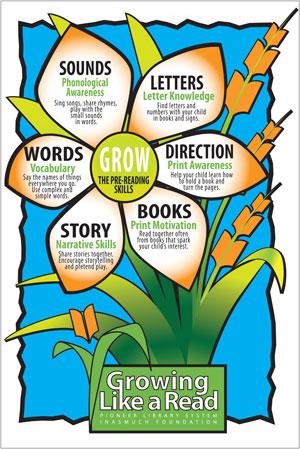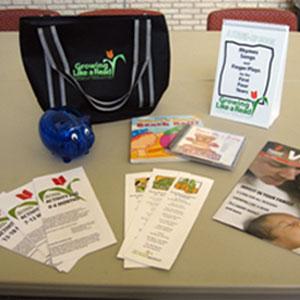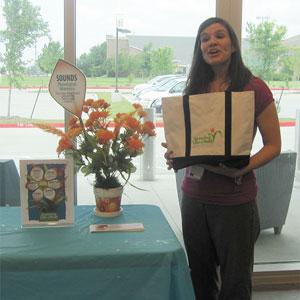Children’s librarians try hard. They buy the best books, attend the best workshops and conferences, plan and deliver the best story times, read the best and latest professional literature, incorporate best practices. But they may only see a child for thirty to forty-five minutes per week or less. Children’s librarians can model, provide information and tips, and recommend books and activities, but they can’t do it all. They don’t have the concentrated time with the children to work on pre-reading skills that paves the way for brain development in young children.
Develop Materials with the User in Mind: Parents and Caregivers
Children’s librarians can offer programs and develop materials that support parents and caregivers in their role as their children’s first teachers. Baby, toddler, and preschool story times provide the perfect opportunity to reach the parents and caregivers as well as the children to demonstrate and market the best materials and methods to develop language and early literacy skills. It has to be up to the parents and caregivers of young children who are with them hour after hour to instill the ritual and repetition necessary for early brain development. Early literacy skills are all about brain development, not learning how to read.
Staff of the Children’s Center of the Pioneer Library System (PLS), a public library system with ten branches that serve a diverse suburban and rural population in Cleveland, McClain, and Pottawatomie counties in central Oklahoma, realized that encouraging parents and caregivers to read aloud to their children was not sufficient. Families, whether because they lived far from the library or because they were constantly on the go, needed to have a book of their own and a series of simple, purposeful activities appropriate to their children’s developmental levels that promoted one-to-one language interaction between the adult and the child.

Use Best Practices
To provide parents with the tools they need to create a language-rich environment and extend learning beyond the library walls, PLS staff researched the literature, attended national trainings, assembled best practices, and developed Growing Like a Read (GLAR). Now in its fourth year, the program is still growing and reaching new families. Branch staff is committed to promoting GLAR to parents in the library and to daycare providers on outreach visits, while Children’s Center staff and GLAR developers Jenny Stenis and Valerie Kimble are focusing on outreach to non-library users.
In research and practice, Growing Like a Read is based on the ALA Public Library Association’s Every Child Ready to Read @ your library (ECRR). ECRR laid out the groundwork for promoting pre-reading skills in the public library. Children’s librarians Jenny Stenis and Valerie Kimble at Pioneer Library System’s Center for Children’s Services ran with it. They developed GLAR, which incorporates all the principles of ECRR and provides materials for the parents and the caregivers to use to work with their children on a one-to-one basis. ECRR research says this is the best way.
Involve Expert Community Partners in Program Development
In developing the GLAR program, Stenis and Kimble realized that they needed expert help to ensure valid and appropriate activities for the children, a program design that would appeal to a grantor, and assistance with incentives from local communities. They turned to community partners, including child development specialists, child psychologists, children’s advocates, educators, even bankers, who were essential to every phase of the project, from planning through marketing and outreach.
GLAR materials were developed in-house by Stenis, Kimble, and other PLS staff, with input from early childhood professionals in the community. PLS children’s librarians were polled for their favorite, public domain nursery rhymes and songs, which were compiled by Valerie Kimble and illustrated by Gary Kramer, PLS Public Information Director. Jenny Stenis laid out charts of activities, called activity logs, for every six-month period from birth to age four with input from Vona K. Bowling, a student in child development at the University of Oklahoma, and Stevie Skaggs, a program specialist in Trauma Focus Services at the Center for Children and Families. Kimble gathered the literacy development tips for the logs, and Kramer did the layout. Lisa Monroe, Child Development Specialist at the University of Oklahoma, was instrumental in designing the program evaluation instrument, a self-administered, written pre-test/post-test.
Once the activity logs were developed, Child Development Specialist Mary Ann Boersma and Speech and Language Specialist Sonja Ice from the Cleveland County Health Department were approached to vet the activities for age and developmental appropriateness. All experts provided valuable insight into appropriate activities based on their knowledge of typical and accelerated and delayed or abnormal child development. For example, learning letters and the alphabet song originally appeared in the two-year-old activity log, but these activities were moved until after age three at Ice’s and Boersma’s recommendation. Other early childhood professionals reviewed the activity logs, including Christy Emig of Success By 6. All feedback received was incorporated.
Community partners were essential for materials development, but their contributions did not stop there. They continue to refer families to the library for GLAR materials, sponsor daycare provider trainings that showcase GLAR, contribute articles to the GLAR enewsletter, and assist with outreach efforts.

Make the Program Widely Available
GLAR is offered at all ten branches of the system and through the PLS Virtual Library. Families who sign up for the program receive a tote bag to carry picture and board books, a standup book of nursery rhymes, and a log of simple activities matched to the child’s developmental age that the parents can do at home, on the go, at bedtime, at the library, or just about anywhere. Activities that develop early literacy skills are organized around six-month periods from birth through age four. The activity log resembles a bingo card, and as groups of activities are completed, parents can receive a board book and CD of nursery rhymes for their home library as well as many opportunities to enter their child in twice-yearly drawings for savings bonds, or the equivalent, from local banks.
Banks in all ten communities, and in some cases, several banks in a town, have generously sponsored these prizes. In addition, the Tinker Federal Credit Union sponsored 1,600 plastic piggy banks to be included as giveaways with GLAR materials. These financial institutions were pleased to partner with the library on a project that represented an investment in children’s futures. Community newspapers assist with marketing efforts by publishing photographs of bankers awarding prizes to the winning babies or toddlers and their families. GLAR awards have even graced the front page!
All GLAR materials are available on request by library customers. The rhymes, songs, and finger plays from the standup book are demonstrated in baby, toddler, and preschool story times at all the branches. Parents are offered GLAR materials in these programs and invited individually to participate. Caregivers who are not able to visit the library can access the contents of the standup book and the activity logs from GLAR page on the library’s website.
Match the Grant Application to the Foundation’s Mission
Families receive the materials free of charge to keep. The Inasmuch Foundation, a local Oklahoma organization, funded the initial purchase and printing of these materials. “Dedicated to the betterment of the neighborhoods in which we live,” the Inasmuch Foundation supports educational and health programs and the arts and the environment, and helps charitable and educational organizations achieve their goals. They post their annual grants on their website, and it is plain to see that they fund early literacy projects. They were a great match for the GLAR program.
Emphasize Staff Training
PLS children’s librarians have been trained in early brain development by the child development staff of the Norman Public Schools, with follow-up trainings by Stenis and Kimble, who also demonstrated how to incorporate the pre-reading skills into their story times. Branch librarians are instructed to model for parents the Stand-Up Book of Nursery Rhymes during story times. Recent workshops with early childhood literacy consultant Saroj Ghoting, funded through Institute of Museum and Library Services grants, provided staff with additional training that refreshed the ECRR philosophy and introduced not only new ways to integrate the pre-reading skill tips into story time dialogue, but also tips in tailoring a multi-age story time for learning pre-literacy skills.
Offer Training to Childcare Providers
But what about all the children whose parents work? Children in day care and Head Start programs? It is the childcare providers who have the concentrated time with these children. To meet these needs, PLS gives a poster version of the standup book to day cares, Early Head Starts, and Head Starts. These resources are distributed through certification trainings on literacy taught by Stenis and Kimble in partnership with the Oklahoma Health Department, Success By 6, and the Oklahoma Department of Human Services, or through outreach visit by PLS staff to individual centers throughout the three counties served by the library system. Techniques for sharing the rhymes and songs with the children are demonstrated during training and site visits. Daycare programs who attend library story times also receive poster sets. They see how the librarians model the rhymes for parents, and how much the children enjoy them. “Do it again” is frequently heard, so adults can see how much the children welcome repetition of these traditional verses that build strong neural pathways for language.
Use the Library Website to Capture Customers
Parents and childcare providers who visit the PLS website can get information about GLAR and also subscribe to a free twice-yearly GLAR enewsletter, with information and tips on area services, an in-depth article on one of the six pre-reading skills, bibliographies of new and recommended titles that relate to that skill, and short articles by child development specialists and child psychologists. The enewsletter addresses ongoing training, current awareness, and readers’ advisory issues. View back issues of the newsletter at the GLAR site.
Adriana Edwards-Johnson, Pioneer Library Virtual Librarian, has recently expanded the GLAR web presence. Customers can sign up for the program just as they would for summer reading programs. On the site there are also PDFs of the activity logs that they may print off, an interactive version of the standup nursery rhyme book, and lists of age-appropriate books by pre-reading skills compiled by Sandy Shropshire of the PLS Children’s Center.
Make Efforts to Reach the Disadvantaged and Underserved

While information delivered through story times, the library website, and library publications reaches active library customers, the current target audience for the GLAR program is parents and caregivers who do not come to the library and who may not be readers. The strategy for GLAR developers Stenis and Kimble is to make contact with community organizations serving disadvantaged families, and to make the program available to them through outreach programs.
Outreach has grown slowly through relationship-building. While branch children’s librarians use GLAR materials on visits to daycare centers in their communities, Children’s Center staff has attempted to reach at-risk groups in the communities. Model story times and GLAR materials are provided to teenage mothers in Cleveland County. Contact for this program was made by Jenny Stenis networking through a committee of children’s services providers. Mothers in Shawnee, Oklahoma, enrolled in Temporary Assistance to Needy Families (TANF), a welfare-to-work program funded by the US Department of Health and Human Services through state block grants, have received sets of GLAR materials and two parent trainings by Valerie Kimble to date. The Shawnee Public Library has an ongoing literacy program with this TANF program, so GLAR was introduced under their auspices with the help of Shawnee Literacy Assistant Beth Lyles. Another partner, Oklahoma Parents as Teachers, a program offered through the local public school system, provides a venue for Stenis and Kimble to present GLAR to parents and their little ones.
Each county served by Pioneer Library System is different in terms of services, organization, and needs, and each branch library has different contacts. GLAR developers are working within and outside the existing library network to establish and implement an effective outreach plan to meet and match these different needs. Perseverance is required. Phone calls are not returned, events get canceled, audiences are small and not always what is expected. It is essential that library staff be reliable, flexible, and good-humored no matter what. The families who come are really committed to their children’s development. They often have no transportation, no support, no money, and limited time. Giving them a book to keep is meaningful. One TANF mother hugged the board book from her GLAR bag to her face and said, “I can read this to my baby!” Then she smiled and rocked in her chair in excitement.
While the library field considers programs like GAR early literacy initiatives, the field of behavioral health considers them primary prevention. Young children who do not receive the kind of stimulation and early learning opportunities that GLAR offers are at risk for developmental delays, speech problems, even emotional issues. Community organizations and agencies such as health departments, guidance clinics, human services, and others are excited about the public library’s efforts to impact and improve early literacy. They readily partner with, advise, refer to, and support programs like GLAR.
Developing and maintaining these contacts is key to program success, and help in identifying those in need is everywhere. Recently Oklahoma passed SB 346, which says, in effect, students who do not read at grade level at the end of the third grade cannot move on to fourth grade. In the new law, schools must focus on intervention and remediation in earlier grades so students will not be held back. Early literacy agencies such as Smart Start, Success By 6, and others wish to partner with libraries to find ways to impact and improve early literacy to positively influence the outcomes for future third graders.
A new initiative for marketing GLAR directly to new parents through local hospitals is in the works. PLS GLAR staff is developing a pamphlet explaining the program in cooperation with Gary Kramer of the PLS Public Information Department, who designed the program’s logo, illustrations, layout, and other materials. A library card application will be part of this publication. Staff hopes to have this ready by fall 2012. Reaching older adults who are non-library users, but who may be the primary caregiver of their grandchild or grandchildren, is another outreach goal. Research is underway on the best method of reaching this population.
Conclusion
Evaluation survey findings to date indicate that current library customers who use GLAR were already fairly knowledgeable about literacy development, but have increased the frequency of reading to their children. This provided the impetus for Stenis and Kimble to reach beyond the library walls and take the program into the community, to reach families who do not use the library and who are in greater need of what this program offers. It is important to get the word out about GLAR or programs like it because every young child from birth needs to be talked to, read to, rhymed with, sung to, and played with in order to develop strong neural pathways for language and pre-reading skills. The more often children experience these language-enrichment and reading-readiness activities, the better. Ritual and repetition are key. A safe environment, a caring adult, and one-to-one interactions create a pleasant learning environment, so talking and reading have positive associations for the child and encourages him or her to grow into a reader.
GLAR is designed to increase parents’ and caregivers’ knowledge of the pre-reading skills, provide them with materials and suggested activities to do with their little ones, and give them ongoing information, training, support, and incentives to encourage these new behaviors. All this with the goal of improved brain development in young children related to language and early literacy. For more information on GLAR, or to offer your ideas, contact Jenny Stenis at 405-701-1835 or jenny@pls.lib.ok.us, or Valerie Kimble at 405-701-1836 or Valerie@pls.lib.ok.us.



